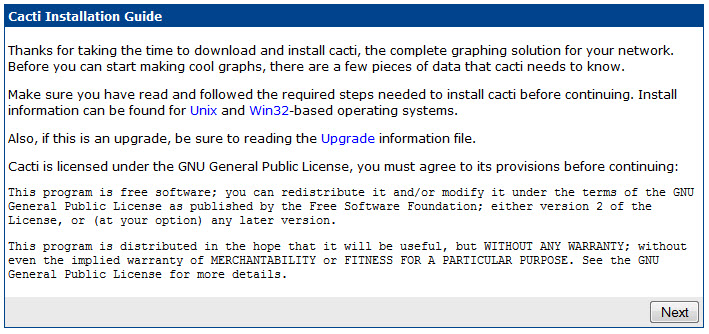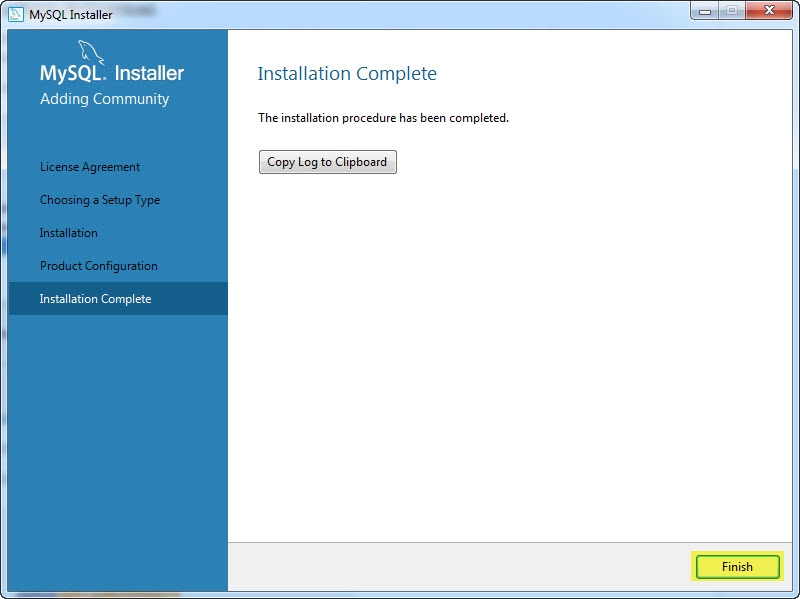Install Cacti On Windows 7
This video is part of a series that will be responsible for presenting the installation of a Cacti server on a computer running Windows 2008. This video will. There’s a new eBook coming up with detailed description of the Cacti installation. Not valid in Windows 95). Error_log = syslog Step 7. New eBook coming up! There’s a new eBook coming up with detailed description of the Cacti installation process on CentOS, Ubuntu, Debian and Windows systems! Go to the eBook product page.
Cacti is one of best monitoring tool used to monitor network, CPU load, memory, Disk and other services and the same in the x86 servers running Windows and Linux OS’es. Cacti uses PHP for front end, RRDTool for graphing and mariadb to store the reporting graph for storage. Cacti installation on centos requires LAMP setup and SNMP.
Before installing cacti, first we need to setup httpd or apache with php, mariadb and SNMP services. In this article we will use CentOS 7 this is the latest release as of writing this post. Before we start make sure you disable the SELINUX if your not familiar on this better disable it now then reboot your server after the change is done home# vim /etc/selinux/config Change it from SELINUX= permissive to SELINUX= disabled Requirements: The Cacti required following packages to be installed on your Linux operating systems like RHEL / CentOS / Fedora. Httpd/Apache: A Web server to display network graphs created by PHP and RRDTool. Mariadb/MySQL: A Database server to store cacti information.
PHP: A script module to create graphs using RRDTool. PHP-SNMP: A PHP extension for SNMP to access data.
Install Cacti On Windows
NET-SNMP: A SNMP ( Simple Network Management Protocol) is used to manage network. RRDTool: A database tool to manage and retrieve time series data like CPU load, Network Bandwidth etc. Step 1: Install the packages needed to run the Cacti such as the mariadb aka mysql, php and the httpd aka apache. # yum install mariadb mariadb-server php php-mysql httpd httpd-devel and then press “y” in your keyboard then press ENTER after that it will install all the required packages needed Step 2: Configure the mariadb and httpd to auto run their services in system startup this is helpful when the system reboots then no need to manually run the script to run again.
Install Cacti On Windows 10
Systemctl enable mariadb.service -This is to enable the service mariadb in startup # systemctl enable mariadb.service Created symlink from /etc/systemd/system/multi-user.target.wants/mariadb.service to /usr/lib/systemd/system/mariadb.service. # systemctl enable httpd.service – This is to enable the service httpd in startup # systemctl enable httpd.service Created symlink from /etc/systemd/system/multi-user.target.wants/httpd.service to /usr/lib/systemd/system/httpd.service. # Then now start both the services by typing # systemctl start httpd.service # systemctl status httpd.service # systemctl start mariadb.service # systemctl status mariadb.service Step 3: Configure the root password of the mariadb database # mysqladmin -u root password ‘abcde12345’ and issue the below command to secure the mariadb database # /usr/bin/mysqlsecureinstallation NOTE: RUNNING ALL PARTS OF THIS SCRIPT IS RECOMMENDED FOR ALL MariaDB SERVERS IN PRODUCTION USE! PLEASE READ EACH STEP CAREFULLY! In order to log into MariaDB to secure it, we'll need the current password for the root user. If you've just installed MariaDB, and you haven't set the root password yet, the password will be blank, so you should just press enter here.
Enter current password for root (enter for none): OK, successfully used password, moving on. Setting the root password ensures that nobody can log into the MariaDB root user without the proper authorisation. You already have a root password set, so you can safely answer 'n'. Change the root password? By default, a MariaDB installation has an anonymous user, allowing anyone to log into MariaDB without having to have a user account created for them. This is intended only for testing, and to make the installation go a bit smoother.
You should remove them before moving into a production environment. Remove anonymous users?
Normally, root should only be allowed to connect from 'localhost'. This ensures that someone cannot guess at the root password from the network.
Disallow root login remotely? By default, MariaDB comes with a database named 'test' that anyone can access. This is also intended only for testing, and should be removed before moving into a production environment.


Remove test database and access to it? Y/n Y - Dropping test database. ERROR 1008 (HY000) at line 1: Can't drop database 'test'; database doesn't exist. Not critical, keep moving. Removing privileges on test database. Reloading the privilege tables will ensure that all changes made so far will take effect immediately. Reload privilege tables now?
If you've completed all of the above steps, your MariaDB installation should now be secure. Thanks for using MariaDB! # Step 4: Create database that will be use to store all the data of Cacti. In mariadb database we will create a name called ‘cactidb’ but first login in mariadb using the command below # mysql -u root -p now create the dabatase called ‘cactidb’ using the commands “create database cactidb” and “grant all on cactidb. to identified by ‘abcde12345’ and then “flush priviledge” this command is to apply all the command changes for this creation.
Oct 3, 2007 - Office 2003 Add-in: Latin and Cyrillic Transliteration enables you to select an area of text within Word 2003 or PowerPoint 2003 to convert it. TranslitGT – Add-In – Programski dodatak za preslovljavanje za Microsoft Office Word 2007 – 2010 – 2013. Sa preko 20 000 preuzimanja u 2013 proverite zašto.  Make sure you have Microsoft Office Word 2007 or 2010 installed; Download the. Preslovljavanje ide bez greške, ali ima jedan problem: kada se preslovljava. Products supported Excel 2013+Excel 2016+Excel OnlinePowerPoint 2013+PowerPoint 2016+PowerPoint OnlineWord 2013+Word 2016+Word 2016 for Mac.
Make sure you have Microsoft Office Word 2007 or 2010 installed; Download the. Preslovljavanje ide bez greške, ali ima jedan problem: kada se preslovljava. Products supported Excel 2013+Excel 2016+Excel OnlinePowerPoint 2013+PowerPoint 2016+PowerPoint OnlineWord 2013+Word 2016+Word 2016 for Mac.
MariaDB (none) create database cactidb; Query OK, 1 row affected (0.00 sec) MariaDB (none) MariaDB (none) grant all on cactidb. to identified by 'abcde12345'; Query OK, 0 rows affected (0.00 sec) MariaDB (none) flush privileges; Query OK, 0 rows affected (0.00 sec) MariaDB (none) Step 5: Install the SNMP RPM package using the command below. The SNMP is use to capture all the necesarry information in the server or network devices such as cpu, memory, hardisk, port usage and etc.
The SNMP agent receives requests on UDP port 161. The manager may send requests from any available source port to port 161 in the agent.
The agent response will be sent back to the source port on the manager. The manager receives notifications (Traps and InformRequests) on port 162.
Install and Configure MySQL for PHP Applications on IIS 7. 5 minutes to read. Contributors. In this article by Introduction While Microsoft® SQL Server® 2008 is the recommended database to use when hosting PHP applications on an Internet Information Services 7 (IIS 7) and above Web server, you can also use MySQL as the database. Currently, many popular PHP applications use MySQL Server for data storage.
Using MySQL requires hosting providers to include MySQL database support with the hosting packages. MySQL cannot currently be installed with the Microsoft® Web Platform Installer (Web PI). This article provides guidance for installing MySQL manually. Install MySQL Server on Windows Server 2008 or Windows Server 2008 R2 It is recommended that you install MySQL on a dedicated server rather than installing MySQL on the same server that is running IIS.
The separation of database server and Web server makes overall installation more secure and manageable and avoids resource contentions between the database and Web server processes. We recommend downloading Windows® Installer. Start Windows Installer, or extract all the files from the archive, and then start Setup.exe. You can use a Typical Setup or customize the installation to suit your needs. Once the installation wizard is completed, it is recommended that you leave the Configure the MySQL Server now check box selected. Configure a MySQL Instance.
Run the MySQL Server Instance Configuration Wizard, and then choose the configurations options that most closely match your environment. For more information, see the. Best practice recommendations are as follows:. Click Next in the Instance Configuration Wizard.
Select Detailed Configuration, and then click Next. Select a server type that best suits your environment. It is recommended to set up a separate MySQL server; when prompted to select a server type, select Dedicated MySQL Server Machine, and then click Next. Select a database option, and then click Next. Select either the Multifunctional Database or Transactional Database Only options if you are using the InnoDB storage engine or the high-speed MyISAM storage engine (for example, if the Web applications on your server require multi-statement transactions, advanced isolation levels and row-level locking, foreign key constraints, or atomic, consistent, isolated, and durable ACID features). These options provides fully ACID transactional capabilities, but at the cost of more aggressive usage of disk space and memory. Otherwise, use the Non-Transactional Database Only option, which is optimized for high-performance SELECT operations.
It has low overhead, in terms of memory usage and disk utilization, but at the cost of not supporting transactions. Choose the option that sets the number of concurrent connections you need. Note Connections require memory; if the number you choose is too big, your server may not have enough memory. You may adjust networking settings to suit your environment or accept defaults, and then click Next.
Select the default character set that best suits you, and then click Next. We recommend enabling both Windows options here. Select both check boxes, and then click Next. Type the password you want to use for the root account, and then click Next. Click Execute to apply your settings. Click Finish to close the wizard.
Install Cacti Centos 7
For PHP to work with MySQL, it is necessary to perform the following modifications to the Php.ini file:. Confirm that the extensiondir points to the folder where all PHP loadable extensions are located, frequently in the Ext folder (for example, extensiondir='. Enable dynamic extension for MySQL by uncommenting the corresponding line for the MySQL extension: extension=phpmysql.dll. c. Save and close the Php.ini file.
Secure MySQL. Remove the anonymous database account (if it exists). Open the MySQL command prompt by clicking Start - All Programs - MySQL - MySQL Server 5.1 - MySQL Command Line Client:. Enter the password for the root account. Once logged on to MySQL, use the following sequence of commands: mysql use mysql; Database changed mysql DELETE FROM user WHERE user = '; Query OK, 2 rows affected (0.03 sec) mysql FLUSH PRIVILEGES; Query OK, 0 rows affected (0.05 sec). Next, restrict the root account to log on only from localhost.